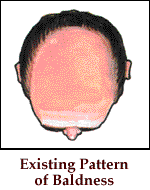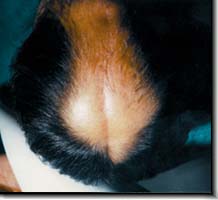
Scalp reductions are probably the most common surgical hair restoration procedure besides transplants. They are necessary because most people have a limited amount of hair for transplantation. Many men who are bald do not have enough hair to cover the scalp and give the appearance of a full head of hair. Scalp reductions are one way of making that possible. Rather than increasing the hairs available, scalp reductions reduce the amount of scalp you have to cover with transplants by removing a section of the scalp.
Although different physicians have different techniques which determine the number of procedures necessary, in general several reduction procedures may be needed to achieve the finished result. The reason is that the skin will only stretch so far to close the wound, so several small reductions must be done, allowing the skin to stretch and grow some after each reduction. Another technique with reduces the amount as much or more is scalp expansion/extension. Instead of several procedures, scalp expansion and extension stretches the skin prior to the reduction so that only two procedures are necessary. Whether a scalp reduction or expansion is done, as soon as the reduction has healed transplants are done to cover any scarring and to achieve the desired results of the patient.
The picture below was provided by the Beverly Hills Institute of Aesthetic and Reconstructive Surgery.
There are a few possible drawbacks to this procedure. One is that a scar is almost always left after the reduction operation. How much of a scar depends on the ability of the doctor as well as how well the patients scalp responds in healing the reduction without scarring. Another drawback is called ‘slippage,’ where the skin that has been reduced expands some to ‘slip’ back down the scalp. In such cases, further reductions would be necessary to remove the problem. Another drawback is the possibility that the balding will continue beyond the area you reduced, creating an odd balding pattern. Further transplants and/or another reduction might be necessary to correct this. Other drawbacks include that it is a more complex operation than a transplant and that it adds heavily to the cost of the transplant.
The benefits are that it may allow pretty spectacular transplant results when done right and the possible appearance of a full head of hair.

The scar left by a scalp reduction in one individual. This picture was provided by New Hair Institute.
Some doctors no longer perform this operation, claiming that new transplant techniques make it possible to give the appearance of a full head of hair without a reduction of the scalp. These doctors are of course competitors to those who perform scalp reductions. They also claim that scalp reductions can lower the amount of donor hair available for transplantation and cause the remaining hair to grow in unnatural directions.
Warning! The pictures in the gallery are graphic depictions of a male pattern reduction and not for those with weak stomachs!
Click here to see the Scalp Reduction Photo Gallery!





